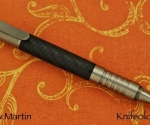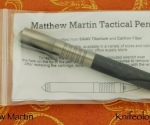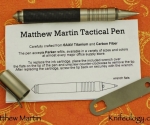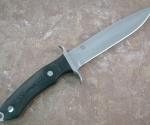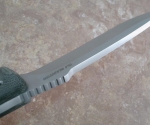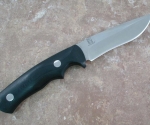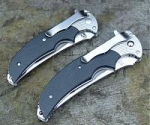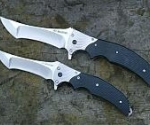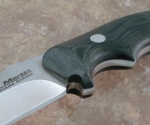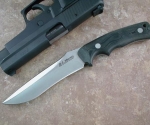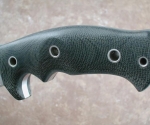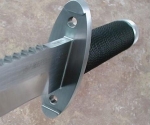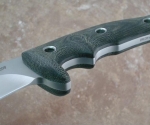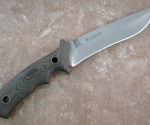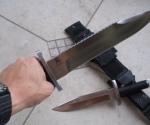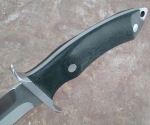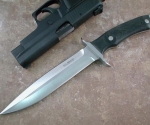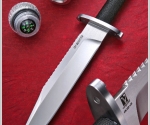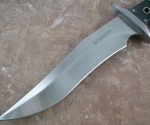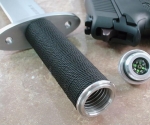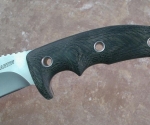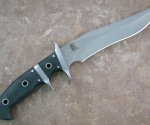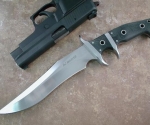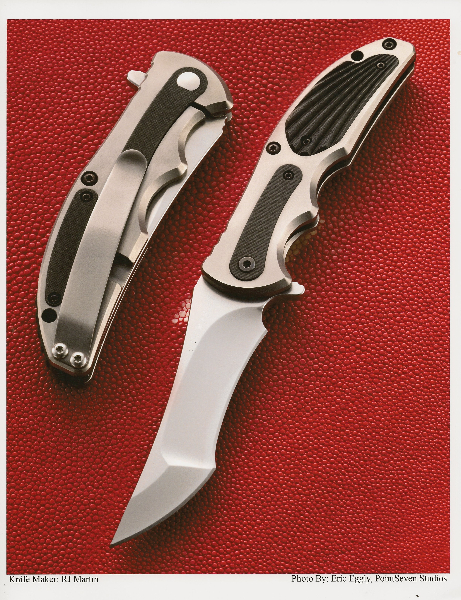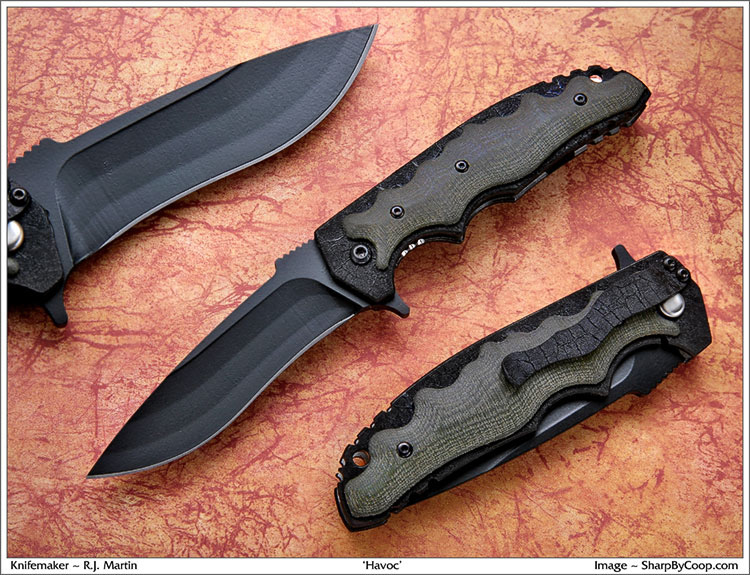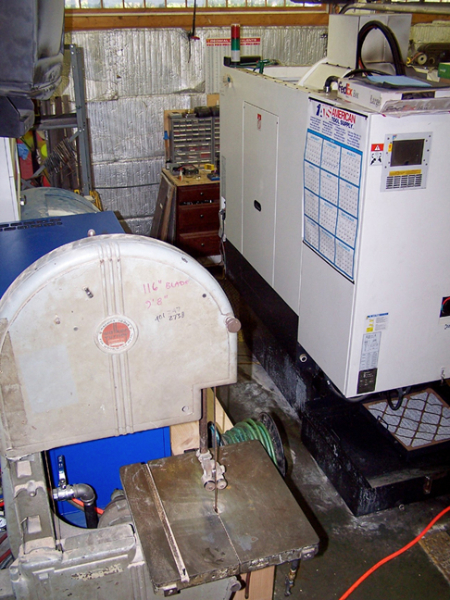My son Matthew is making some great tactical pens, check them out here! mcmpens.com
Author Archives: rjm
Dealer / Links
Coming Soon…
Vanguard
Over the past 6 years, I have had the privilege to design 12 knives for the VANGUARD Series, offered by Purveyor Les Robertson.
Each of these knives was part of a numbered, limited edition series. These pictures are posted here to archive my work, and to show you the extent of my capabilities in tactical fixed blades. Folders and D/A autos. In this series, the only knife currently available is the Trailblazer. Every other knife is sold out, but, you can still enjoy the pictures!
Hover over the picture for a larger view.
THESE KNIVES ARE NO LONGER AVAILABLE-visit www.robertsoncustomcutlery.com to check availablilty on the aftermarket.
Contact
Please email me at rjmartinknvies@comcast.net
SHOW SCHEDULE-2012
East Coast Custom Knife Show 2012
March 2, 3, 4, 2012
The Westin Hotel – Jersey City Newport
479 Washington Boulevard
Jersey City, New Jersey 07310For Hotel Information Call: 201-626-2900
Friday – 1:00 pm – 6:00 pm
Saturday – 10:00 am – 6:00 pm
Sunday – 10:00 am – 3:00 pm
2011 BLADE Show & International Cutlery Fair
June 8-10, 2012
Cobb Galleria Centre, Atlanta, GA
USN GATHERING 2012
Planet Hollywood Hotel
3667 Las Vegas Boulevard South
Las Vegas, NV 89109
Reservations: 1-866-317-1829
Reservation Code: SMUSN1
Dates:
Labor Day Weekend September 1st , 2nd & 3rd 2011
Registration:
Thursday Sept 1st, 12 noon to 6 pm
Friday Sept 2nd, 9 am to 6 pm
Saturday Sept 3rd, 9 am to 5 pm
Show dates and times:
Friday Sept. 2nd 10 am to 6 pm
Saturday Sept. 3rd 10 am to 6:30 pm
The 35th Annual NYCKS
TBD

DRT (Dead Right There)
Blade Steel: CPMS30V, Rc60. Tumble finish, non-reflective
Blade Length: 4″
Overall Length: 8.75″
Frame: 3/16″ thick Titanium. Ceramic bead blasted.
Clip: Orange Peel Titanium, tip-up carry.
Inlays:4 inlays, textured Carbon Fiber.
- Roller Thrust Bearings.
- Inlays and clip are specially designed to cover the locking bar slot and to keep the user’s fingers off the locking bar during opening. Lock-side inlay acts as an over-travel stop for the lock.
- Interior pockets are machined in the frames to remove 30% (1 oz) of the weight from the frames.
- 25 numbered knives were produced. SOLD OUT
HAVOC
Wreak HAVOC on all your cutting tasks…
The HAVOC offers all the high-end features of the DEVASTATOR in a scaled down package that is perfect for everyday carry. Incorporating thick titanium sideplates, and my awesome roller bearing system, the HAVOC is as fast as an auto to deploy, and totally reliable.
The unique faceted blade, the first of it’s kind in the world, gives the HAVOC a unique personality in a sea of hum-drum competition. This knife has already been featured in several major knife publications, including the April, 2007 issue of Blade Magazine.
Blade Steel: CPMS30V, Rc59
Blade Length: 3.5″
Blade Thickness: .130
Overall Length: 7.9″
Handle Length:4.4″
Blade Finish: Black Epoxy Powdercoat
Handle Material: .125 thick Powdercoated Titanium frames w/CNC textured Green Canvas Micarta overlays
Shop Tour
Since 1976, I have had four different workshops. The first had only one stationary grinder, the 6″ x 48″ machine you’ll see in the photo tour, and occupied a tiny part of my parent’s basement.
Things have changed a great deal since then-My current shop is 24’ x 24’ with 12 foot ceilings. Plenty big for a one-man shop. It contains pretty much every tool I want and need to build precision knives of the highest quality. It is (generally) clean and well lit, heated in the winter and air-conditioned in the summer. It is not probably the prettiest shop you will ever see, but it is well organized and very efficient. It is a place I enjoy being in and is most definitely a reflection of my personality.
Everything in it works as it should, and I know each-and-every machine’s personality. It may sound odd, but I have come to understand and respect these machines and tools in a way that pleases me to no end. Maybe that is the true meaning of “Working with tools”.
Sit back and enjoy the tour!
RJ Martin
FAQ
Questions, Frequently Asked:
1. What kind of steel do you use, and why?
2. What are the benefits of blade coatings?
3. What are the characteristics of a superior knife?
4. In your opinion, what defines a “Tactical” knife?
5. How do you heat treat your blades?
6. Are your knives guaranteed?
7. What is your personal philosophy about Knife making?
8. How should I sharpen my RJ Martin Knife?
9. Should I lubricate my RJ Martin folding knife?
10. What does the “RJ” in RJ Martin stand for?
What kind of steel do you use, and why?
Steel is what gives a fine knife its potential. Potential that is realized only through proper heat treatment. I am thankful that recent new technologies provide alloys that were unthinkable just a few years ago. Here are some of my thoughts on steels I use, and steels I don’t use:
- CPMS30V is the finest martensitic stainless steel in the world today. Developed by Crucible Materials Corporation, and made using their proprietary process, this steel offers toughness, high wear resistance and great corrosion resistance. Crucible has a unique process that allows higher alloy contents of key elements like Vanadium to be added, and yet provides an incredibly fine grain size to be maintained. These two factors assure high wear resistance and increased toughness. The 4% Vanadium creates Vanadium Carbide, the second hardest carbide in existence, and in doing so frees up the Chromium so it can resist corrosion. The technology is incredible. CPMS30V is an ideal choice for tough use knives where corrosion resistance is important. This makes it my #1 steel for folding knives and utility knives where low maintenance is desired. My preferred heat treatment for this steel includes three tempers and a cryogenic treatment that results in a final hardness of Rc59/60. Oh, and I can make this steel scary sharp, too.
- BG42 is a superior, ball bearing grade stainless steel. It’s made in the USA by Latrobe Steel, and it is similar in composition to CPMS30V, but with less Vanadium. It takes a higher polish than S30V, but doesn’t have the performance of S30V, and so I use it mostly on fancier knives where appearance is paramount. It’s not available in many stock sizes, either, so it is limited in that respect as well. I should mention that BG-42 requires a complex heat treatment process at temperatures that are beyond the capability of many knife makers who do their own heat treatment.
- CPM3V is the toughest high-alloy knife steel I have ever seen. Basically, particle metallurgy A2 steel, with added Vanadium, this alloy is the perfect choice for large knives subject to impact during use-Camp knives, bushwhackers, etc. I have actually bent CPM3V blades at Rc58!!! It’s not stainless but, because it has 7.5% Chromium it is still a relatively low maintenance steel.
- A2 is an extremely tough, fine grained tool steel. I like this steel for my chisel ground, Japanese knives at a hardness of Rc 60. A2 takes an extremely keen edge, and holds it well. Its high toughness makes it suitable for knives that are going to take impact and bending. A2 will stain if exposed to the elements, which is why all my Japanese knives have wood lined sheaths. The wood retains penetrating oil (Tuf Glide) and protects the blade. A2 is also easy to sharpen and maintain for the average user, which is important if you use your knives hard.
- CPMS90V The hands down winner for the most wear resistant stainless. Also, the hardest steel to finish. If you need steel that will stay sharp during normal use, and you need high corrosion resistance, this is a great choice. Kitchen and fillet knives are simply fantastic candidates for this alloy. You will notice that I don’t offer ATS-34 as a standard blade material. Simply put, I have not found it to make a great blade. It has rusted on me, and reveals impurities during polishing. And it isn’t made in this country. Metallurgically, I think it’s mediocre (no Vanadium).
Remember, you don’t need to be a steel expert. That’s my job! You do need to decide WHERE, HOW and FOR WHAT PURPOSE you want to use your knife. If you tell me this, I’ll give you the best steel possible for YOU.
What are the benefits of blade coatings?
Blade coatings provide some nice options in a tactical knife. I offer Black Epoxy Powder coating applied electrostatically and then baked to a durable finish.
This coating offers some TACTICAL advantages:
- It eliminates reflection, and colors a blade black.
- It greatly increases corrosion resistance of tool steels.
- Where possible, you will find screw on handles on my fixed blade knives with coated blades. This way, if you damage the coating during extreme use, you can simply unscrew the handle scales, and have the blade re-coated.
- Coated blades can, and will, scratch with hard use. Even so, they are of great benefit.
- I do not offer coated blades on Japanese style knives.
What are the characteristics of a superior knife?
Actually, no one has ever asked me that question, probably because most people think they know the answer! But, I think it’s a good question. It’s not easy to answer briefly, but I’ll try.
A superior knife will:
- Balance at the correct point for the cutting motions consistent with the knife’s intended use.
- Feel good in the hand, in a variety of positions, after extended use. (sharp corners are OUT, ergonomics are IN)
- Be “lively” in the hand. You’ll want to go cut something. This is a VERY subtle point, that results from design, execution, balance, etc. When you pick up your first “lively knife”, you will understand. You will want to buy it, and you’ll LOVE to use it!
- Cut and cut and cut and cut!! Yes people, that is why you are buying a custom knife, isn’t it? Sharp is what it’s all about for me. I believe that examining the edge of a finished knife is an excellent way to evaluate the character of the maker. If it’s not SCARY SHARP, it’s not superior.
What defines a “Tactical” Knife?
I used to think that “tactical knives” were just knives with Bead blast finishes and Black Micarta Handles. I was so wrong! A truly “Tactical” knife is a masterpiece of form and function, disguised in a plain brown wrapper. What makes a tactical knife beautiful is how well it works.
If it’s really tactical, it has:
- A highly efficient, compact design that balances strength, weight and speed of deployment and use.
- An ergonomic handle, usually slim, that offers a secure grip, in a variety of grip positions, and protects the fingers from slipping onto the blade. Oil, blood, mud, petroleum products and water must not affect the grip.
- The ability to take abuse, withstands environmental extremes, and keeps cutting.
- A carry system (more than just a sheath!) that makes the knife accessible from a concealed position, quickly, and quietly. A good sheath should provide multiple carry options.
Many so called “Tactical” knives seem to fall short of excellence in the functionality department. They look good, but that’s about it. I try to design a tactical knife the way I design a structural part for a helicopter-get the job done, simply and efficiently, with function as the main goal. A really good tactical knife might not win any beauty contests, but it will be AWESOME to use!! The phrase “A wolf in sheep’s clothing” comes to mind….
How do you heat treat your blades?
The most exciting and important step in the making of a custom knife is the heat treatment. While some makers rely on outside sources for heat treatment of their blades, I choose to perform this critical function myself. I have almost $10,000 invested in state-of-the-art heat treating equipment, the centerpiece being a Cress C1228 digitally controlled furnace that is accurate to a mind-boggling ¼ of 1%. That’s just 5 degrees Fahrenheit at 2000F. Because I use only air hardening steels, I can use a technique called press quenching, whereby blades wrapped in special hi-temperature stainless foil are quenched between thick plates of precision machined Aluminum. This quench is faster than that obtained in a positive pressure vacuum furnace, and has the added advantage of keeping the blades perfectly flat. All my heat treat cycles are monitored electronically and manually, and I calibrate all my equipment to assure consistency. I use only the highest quality SS tool wrap foil, paying nearly twice the price per roll to obtain the best product. Remember, I am a Materials Engineer, and when it comes to heat treatment, I think it is fair to say that I am smarter than the average bear!!
I employ three tempers and a cryogenic treatment using liquid Nitrogen to assure the highest possible level of Martensitic transformation.
I own and use a Rockwell Hardness testing machine, and all my blades will continue to be 100% tested.
Are your knives guaranteed?
Yes, for life, for the original owner, for as long as I am able to work. Natural materials are not guaranteed, because they are subject to a variety of natural processes (aging, shrinkage, warpage) that I am not able to control. I will replace natural materials for a reasonable fee. Damage due to obvious abuse isn’t covered; please respect the limits of your tools and don’t use a knife when you need a screwdriver or a prybar, unless it’s an emergency!! Now, I’m not a lawyer, and don’t believe they need to be involved here! Use your head when you use your knife and it’ll hold up just fine!!
Resharpening is FREE, as long as you send me $20 which covers return postage / insurance. I’m a voting member of the Knife maker’s Guild, and I am here to stay!
What is your personal philosophy about Knife making?
For me, it’s all about quality. I use the highest level of technology available-If I don’t have it, I obtain it and learn how to use it. My CNC is a perfect example of this. I have invested thousands of dollars on this technology have invested thousands of hours mastering its use. Why? To achieve levels of PRECISION and REPEATABILITY that the other guys can’t match. My folders are actually pressed together. There is no play, no slop and no variability.
But machines can’t do the things that make a knife beautiful. I have over 25 years of practice and experience that I put into every blade I grind and every handle I shape.
If you want to know how my philosophy works, just feel the edge on one of my knives. It’s not just sharp….It’s SCARY SHARP.
Nothing less will do.
How should I sharpen my RJ Martin Knife?
If you require the original, Scary Sharp edge that your knife originally had, I offer free re-sharpening. You may send the knife to my shop:
RJ Martin Design, Inc.51 Bramblewood St.
Bridgewater, MA 02324
Please enclose $30 to cover return 2 day FEDEX and insurance. For fastest service, specify a shipping address that FEDEX will deliver to. Turnaround is usually within 48 hours.
If your knife needs some clean-up to remove scratches, etc., indicate that you want it done and add $20-I’ll do my best to restore it to its original condition.
If you want to sharpen your knife at home, I recommend the Spyderco Sharpmaker system. It’s foolproof and will work well on all the steels I use. I recommend starting with the finest rods-If that doesn’t restore the edge quickly, then go to the medium rods and finish off with the fine rods. Stropping the edge on the back of a leather belt is recommended as the final step.
Should I lubricate my RJ Martin folding knife?
Lubrication is generally not required, and can cause the locking bar to stick during lock-up.
If you carry your knife regularly, you’ll want to clean it periodically. I recommend the following:
- Use Fantastic (yellow bottle-lemon) or Formula 409(white bottle-no bleach) pump spray at close range to blast clean all surfaces of the knife. Do this outside or over a garbage can, because it’s messy. Open the knife and repeat. If you have access to an air compressor, blow out the knife thoroughly. Close the blade and blow off the tang thoroughly.
- If you don’t have a compressor, close the blade and wrap the knife in a paper towel and shake it, then wipe it dry. After cleaning, the action should be smooth.
- If your folder has a black stop pin, a bit of Tuf Glide should be applied to it with a Q-tip.
- If you just have to lubricate the pivot, use a toothpick to apply 1 small drop of WD-40 to each washer. If you get oil on the tang, use a Q-tip with acetone to remove all of it from the tang and locking bar.
BTW, if you clean your knife as I recommend, disassembly (blade removal) is seldom required.
What does the “RJ” in RJ Martin stand for?
My full name is Randall James Martin but I prefer to be called RJ.
A few words from me to you….
Hi, my name is RJ Martin, and I am happy to welcome you to my website.
Since Custom Knife making isn’t a common profession, I’d like to tell you a bit about how came to be a full time knife maker. I made my first custom knife in 1976, as a teenager. Being an avid fisherman, I loved to read the outdoor magazines, and the pictures in a Sports Afield article about Bob Dozier, peaked my interest. Those dropped hunters were beautiful! My father was an artist, and, I had already built fishing rods, lures, flies, and archery equipment, so I decided to build my first knife. It came out pretty well, and, the next was even better. You know the rest-I was hooked. But, it got better from there.
I was so fascinated by steel and its heat treatment that I decided to become an Engineer. I graduated from Rensselaer Polytechnic Institute in Troy, NY in 1984 with a BS in Materials Engineering. I started life in the professional world as an Airframe Designer with Sikorsky Aircraft in Stratford, CT.
Over the next 17 years, I was privileged to work on some of the finest helicopter designs in the world. The S-92, shown below, occupied much of my time during the mid-90’s. I served as the Airframe Co-Design Lead for the cockpit, which was designed in Taiwan as part of a joint venture. The Canopy structure is an all-composite design, made largely of Carbon Fiber and Titanium. I received my first patent on this aircraft, for the cockpit window jettison mechanism.
 After the S-92, I served in the same capacity on the MH-60S. During this program, high speed machining was introduced as a means to produce components faster and more accurately. I was fortunate to become involved in this effort, and immediately recognized the benefits of CNC technology. I knew I had to have a CNC of my own, and, purchased a machine in 1999. More on this later…
After the S-92, I served in the same capacity on the MH-60S. During this program, high speed machining was introduced as a means to produce components faster and more accurately. I was fortunate to become involved in this effort, and immediately recognized the benefits of CNC technology. I knew I had to have a CNC of my own, and, purchased a machine in 1999. More on this later…
The MH-60S provided me with my greatest design challenge: Designing a cabin floor that incorporated an integral roller system for loading and moving 3000 LB pallets of cargo within the cabin of the aircraft. My experience in making folding knives helped me develop some of the stops and latches that were used. I was fortunate to have Knife making as a second job! Many of the lessons I learned in Knife making helped me solve problems in helicopter design, and vice versa. We actually solved a difficult design issue by using KYDEX, a common knife sheath material, to fabricate some tricky air conditioning ducts!
I served as Chief of Design of the MH-60S for two years, before I retired in 2001 to become a full-time knife maker. I cannot imagine a better combination of careers. I was privileged to work with some of the finest people I have ever met, designing the finest aircraft in the world. Now, I am privileged to apply the skills I acquired to design and build some of the finest knives in the world.
Every time a helicopter flies overhead, I have to look up and see if it’s one of “mine”.
Stay Sharp,
RJ Martin

